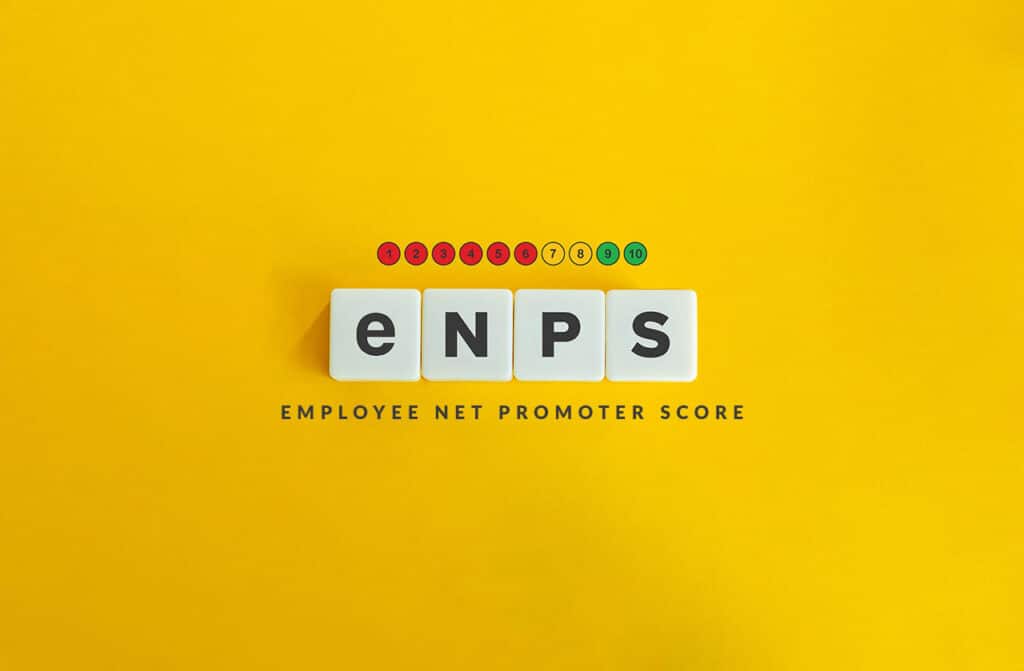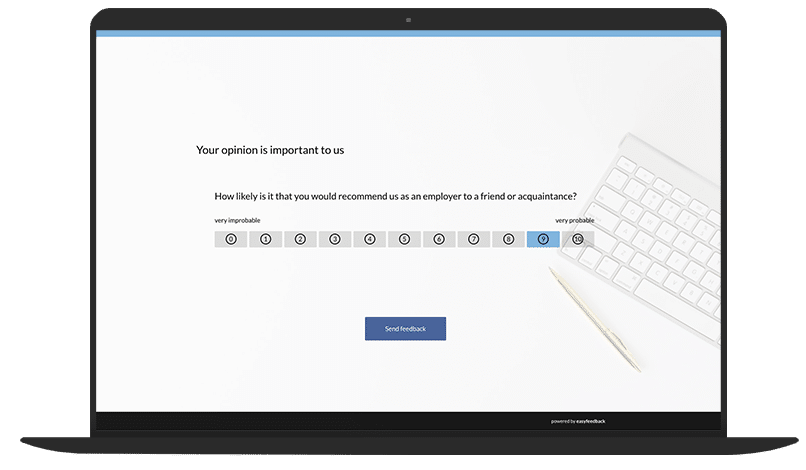What is the Employee Net Promoter Score (eNPS)?
The Employee Net Promoter Score (eNPS) is an important indicator for measuring employee loyalty and retention in a company.
Based on the concept of the Net Promoter Score (NPS) for customer satisfaction, employees are asked to indicate how likely they are to recommend the company as an employer to friends or acquaintances on a scale of 0 to 10.
Employees who give a 9 or 10 are classified as “Promoters”, as they would actively support and recommend the company.
Those who give a 7 or 8 are considered “Passives”, while employees who give a score of 0 to 6 are considered “Detractors”.

The eNPS is calculated by subtracting the percentage of promoters from the percentage of detractors. The result is between -100 and +100.
A high eNPS indicates strong employee retention and loyalty, while a low eNPS can indicate potential problems with employee satisfaction.
Overall, the eNPS is a valuable metric for companies to gauge the mood and engagement of their employees, identify any issues and derive targeted measures to improve employee retention and satisfaction.
The advantages of eNPS for companies
The Employee Net Promoter Score (eNPS) opens up a wealth of benefits for you and your company.
By regularly recording the eNPS, you gain a better understanding of the loyalty and commitment of your employees to the company.
This allows you to identify potential employee satisfaction and retention issues early on and take appropriate action to resolve them before they get worse.
In addition, the eNPS helps to identify specific areas where improvements are needed to increase employee retention and satisfaction.
By taking targeted measures to improve workplace culture and the working environment, you can sustainably increase employee satisfaction and productivity.
By comparing the eNPS with benchmarks in your industry or region, you will gain valuable insights into your performance in the area of employee retention and satisfaction. Based on these findings, you can adjust and optimize your strategies in a targeted manner.
Overall, the eNPS provides an effective tool for measuring employee loyalty and retention, allowing you to identify potential problems at an early stage and introduce targeted measures to improve workplace culture and the working environment.
Implementation of the eNPS in companies
Implementing the Employee Net Promoter Score (eNPS) in your company can be done in several steps:
Step 1: Clarify the goals
Clearly define why you want to introduce the eNPS and what goals you want to achieve with it. Do you want to measure employee satisfaction, improve employee retention or simply receive feedback from your employees?
Step 2: Selecting the survey format
Decide how you want to measure eNPS in your company. This can be through regular surveys, digital tools or other methods.
Step 3: Determine the question formulation
Formulate questions that you want to ask your employees in order to calculate the eNPS.
As a rule, this question is:
“On a scale of 0 to 10, how likely is it that you would recommend your company as an employer to a friend or acquaintance?”
Step 4: Conducting the survey
Conduct the eNPS survey in your company. Make sure you involve all employees and clearly explain to them why you want to collect the feedback and how you want to use it.

Step 5: Calculate the eNPS
Calculate the eNPS by subtracting the percentage of promoters (rating of 9 or 10) from the percentage of detractors (rating of 0 to 6).
Step 6: Analyze the results
Analyze the results of the eNPS to identify trends and patterns. Identify the areas where improvements need to be made and develop appropriate measures.
Step 7: Communicate the results
Share the results of the eNPS with your employees and explain what actions should be taken based on the feedback. Make sure you are transparent and encourage employees to actively participate in improving the work environment.
Step 8: Continuous feedback and improvement
Use the eNPS regularly to get continuous feedback from your employees. Use the results to make ongoing improvements and ensure that employee retention and satisfaction is increased in the long term.
How is the eNPS calculated?
The Employee Net Promoter Score (eNPS) is calculated based on employees’ answers to a simple question:
“On a scale of 0 to 10, how likely is it that you would recommend our company as an employer to a friend or acquaintance?”

Based on their answers, employees are divided into three categories:
1. Promoters
Employees who give a rating of 9 or 10. They are loyal and would actively recommend the company to others.
2. Passives:
Employees who give a rating of 7 or 8. They are satisfied with the company, but not as enthusiastic as the Promoters.
3. Critics:
Employees who give a rating of 0 to 6. They are dissatisfied with the company and may even speak negatively about it.
To calculate the eNPS, simply subtract the percentage of detractors from the percentage of promoters.
The formula is eNPS = % promoters - % critics
For example, if 40% of employees are promoters and 20% are detractors, the eNPS would be
eNPS = 40 % – 20 % = 20
In general, the eNPS value can be a positive number, a negative number or even zero.
A positive value indicates positive employee feedback, while a negative value can indicate potential problems with employee retention. A value of zero means that the number of promoters is exactly the same as the number of detractors.
What is a good eNPS score?
A good eNPS value depends on various factors, including the industry, company size and regional differences.
In general, however, it can be said that an eNPS value above 0 can be considered acceptable, as this indicates that there are more promoters than detractors.
An eNPS value that is significantly above 0 is even better and indicates that a significant number of employees would actively recommend the company to others.
A score above 30 is often considered good and a score above 50 is considered excellent.
It is important to note that eNPS should be used as a benchmark over time to identify trends and track changes in employee satisfaction and retention.
A steady increase in eNPS over a period of time may indicate that the measures taken to improve employee retention are effective.
However, it is also important to look at eNPS in conjunction with other metrics and contextual information to get a comprehensive picture of employee satisfaction and retention.
How often should the eNPS be measured?
The frequency with which the Employee Net Promoter Score (eNPS) is measured depends on the individual needs and goals of the organization.
However, there are some best practices that can be considered when determining the measurement interval:
1. Regularity
It is recommended to measure eNPS at least once a year to identify long-term trends and track changes in employee engagement and satisfaction.
2. Short-term measurements
During times of change or when introducing new programs or initiatives, it may be useful to measure eNPS more frequently to capture the immediate impact of these changes.
3. Event-driven measurement
During specific events or milestones in the organization, such as mergers and acquisitions, restructuring or major strategic initiatives, additional measurement of eNPS may be useful to understand the impact of these events on employees.
4. Continuous feedback
Some companies conduct eNPS on an ongoing basis, possibly in the form of regular pulse checks or feedback loops, in order to respond quickly to changes in employee sentiment.

Finally, I would like to emphasize that the frequency of eNPS measurement aims to strike a balance between sufficient data collection for meaningful analysis and the flexibility to respond to changes in a timely manner.
It is very important that the frequency of measurement is chosen to suit the individual needs and resources of the organization while allowing for continuous monitoring of employee retention and satisfaction.
What factors influence the eNPS?
The Employee Net Promoter Score (eNPS) is influenced by various factors that can affect employee engagement, satisfaction and retention.
Some of the most important factors that can influence the eNPS are:
1. Organizational culture
A positive and supportive organizational culture can increase employee engagement and satisfaction, which can have a positive impact on eNPS.
2. Leadership style
The leadership style of managers has a major impact on employee engagement and retention.
A supportive and inspiring leadership style can help to improve eNPS, while an authoritarian or demotivating leadership style can potentially have a negative impact.
3. Communication
Open and transparent communication between employees and managers can increase employee trust and satisfaction, which can have a positive impact on eNPS.

4. Remuneration and recognition
Appropriate remuneration and recognition of employees for their performance can increase commitment and satisfaction and thus improve eNPS.
5. Working conditions
A pleasant working environment, sufficient resources and support in the workplace can promote employee well-being and have a positive impact on eNPS.
6. Career opportunities
The opportunity for professional development and career progression within the company can increase employee retention and therefore improve eNPS.
7. Work-life balance
A good work-life balance can promote employee well-being and have a positive impact on eNPS.
8. Experiences in everyday working life
Positive or negative experiences that employees have in their daily working life can have an impact on their satisfaction and loyalty and thus influence the eNPS.
As you can see, a variety of internal and external factors can influence eNPS. By understanding these factors and taking targeted measures to improve them, you can increase employee retention and satisfaction and thus improve the eNPS.
Tips for optimizing the eNPS
There are some tried and tested tips for optimizing the Employee Net Promoter Score (eNPS).
In the following, I present a few possibilities:
1. Conduct regular eNPS surveys
Conduct regular eNPS surveys to get continuous feedback from your employees and identify trends over time.
2. Transparent communication
Ensure that eNPS objectives and results are communicated transparently so that employees understand why the feedback is being collected and how it will be used.
3. Active action planning
Develop a concrete action plan based on the results of the eNPS and implement these targeted measures to solve problems and improve employee retention.
4. Management involvement
Actively involve managers in improving the eNPS by providing training and education programs to strengthen their leadership and motivation skills.

5. Reward and recognition
Recognize employee achievements and reward them appropriately for their contributions to the company’s success to increase engagement and satisfaction.
6. Use feedback
Use feedback from eNPS surveys to drive continuous improvement in various areas of the organization, including work environment, culture and working conditions.
7. Continuous monitoring
Regularly monitor the eNPS and progress in implementing measures to improve employee retention and satisfaction.
8. Benchmarking
Compare the eNPS with benchmarks in your industry or region to assess your performance and identify potential for improvement.
Conclusion: eNPS – a key figure that provides valuable information
The Employee Net Promoter Score (eNPS) is undoubtedly a key performance indicator that provides valuable information about a company’s employee loyalty.
By directly asking employees about their willingness to recommend their employer to others, the eNPS provides a quick and easy insight into the engagement and loyalty of the workforce.
The strength of the eNPS lies in its simplicity and its ability to quickly obtain feedback from employees.
Companies can use eNPS to spot trends, identify potential issues early and take targeted action to improve employee engagement.
However, the eNPS should not be viewed in isolation.
To get a comprehensive picture of employee satisfaction, it is important to combine eNPS with other metrics and feedback mechanisms.
Overall, eNPS is a valuable metric that helps companies measure, understand and improve their employee retention in the long term, which in turn contributes to a positive company culture and long-term success.
If you would also like to use the eNPS as a tool to assess employee retention, easyeedback offers you an uncomplicated solution.
Use our ready-made survey template, adapt it to your requirements and get started right away.
More on the topic of employee retention
- Why employee retention is more important than ever
- 6 methods to measure employee retention
- 6 pillars of employee retention
- 8 measures to increase employee retention
- 5 Methods for measuring the employee experience
- The turnover rate: a key figure for measuring employee retention
- How surveys can help reduce employee turnover!
- The sickness absence rate: an indicator of employee loyalty
- How surveys can help reduce the sickness rate!
- 6 KPIs and metrics for measuring employee retention





